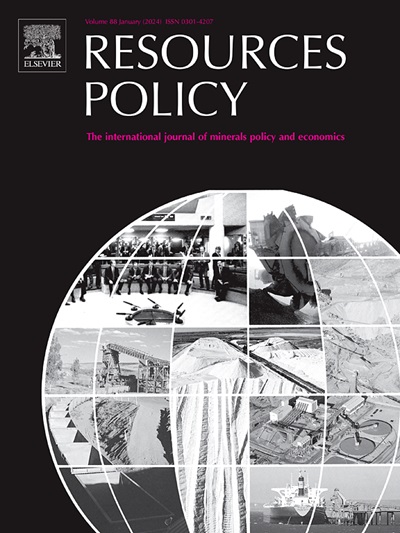Rehabilitation costs paid by mining enterprises in Turkey: Comparison of rehabilitation costs with their shares in mining operation costs and other environmental costs
IF 10.2
2区 经济学
0 ENVIRONMENTAL STUDIES
引用次数: 0
Abstract
Environmentally sustainable mining operations are becoming more and more important today. In this respect, the shares of different environmental costs paid by mining enterprises in mine operating costs are of interest. In Turkey, mining administrations collect environmental costs such as forestry costs and environmental compliance fees from mining enterprises using different calculation methods. Mining waste management costs and rehabilitation costs, on the other hand, are the costs that mining enterprises spend independently from mining administrations during the mining operating period to ensure compliance with the legislation. Among these, rehabilitation activities, which are considered at the center of the study, are evidence that mining enterprises are mining in harmony with the environment in a sustainable framework with their specific activity stages. Rehabilitation costs spent for rehabilitation activities are costs made at different stages of mining operations. In Turkey, rehabilitation costs are spent by mining enterprises on their initiative, but ignored by the administrations and the public. Because these costs are not paid to the administrations, the public can't have information about how much money is spent. The calculation of the ratio of this cost to the operating cost by considering the duration of mining operations may help the administrations to determine the optimum calculation methods of environmental costs in the presence of other environmental costs and to consider these costs in total. In this study, it is aimed to see environmental costs as a whole by emphasizing the rehabilitation costs of mining enterprises. It is also aimed to contribute to the post-mining sustainable land use process and forestland use. Accordingly, the ratio of rehabilitation costs contributing to used and returned forest areas to operating costs was considered and compared to each other in order for the Ministry of Agriculture and Forestry to reconsider the calculation methods of different types of forest costs charged from mining enterprises. In this way, this study also aims to raise awareness about the costs charged by the administrations from the enterprises and how much these costs constitute a total cost in the eyes of different ministries & administrations in terms of the annual costs of the enterprises. To this end, rehabilitation costs, waste management costs, environmental compliance fees, and forestry fees were compared together with their ratios to operating costs, and their changes according to mineral groups were analyzed. This study provides recommendations to policymakers on the nature and management of different environmental costs of mining enterprises that spend on environmentally compatible mining. This study also calculates rehabilitation costs per 1 ha of mining permit area and ton of mineral production. The study also analyzed whether rehabilitation costs are related to the area of forest used and returned, forest quality, and the level of importance of recreational forest use in cities. Additionally, an assessment was made as to whether rehabilitation costs also increase as these areas increase in total.
土耳其矿业企业支付的恢复成本:恢复成本与其在采矿作业成本和其他环境成本中所占份额的比较
环境可持续的采矿作业在今天变得越来越重要。在这方面,矿山企业所支付的不同环境成本在矿山经营成本中所占的份额是值得关注的。在土耳其,矿业管理部门使用不同的计算方法向矿业企业收取环境成本,如林业成本和环境合规费。另一方面,采矿废物管理费用和恢复费用是采矿企业在采矿作业期间独立于采矿行政当局支出的费用,以确保遵守立法。在这些活动中,被认为是研究中心的恢复活动证明,采矿企业在可持续的框架内,在其具体的活动阶段,与环境和谐地进行采矿。用于恢复活动的恢复费用是在采矿作业的不同阶段支付的费用。在土耳其,恢复费用由采矿企业主动支付,但被行政当局和公众忽视。由于这些费用没有支付给行政部门,公众无法知道花了多少钱。通过考虑采矿作业的持续时间来计算这一费用与作业费用的比率,可能有助于行政当局在存在其他环境费用的情况下确定环境费用的最佳计算方法,并从总体上考虑这些费用。在本研究中,通过强调矿山企业的修复成本,旨在将环境成本作为一个整体来看待。它还旨在促进采矿后的可持续土地利用进程和林地利用。因此,考虑并比较使用和归还森林面积的恢复费用占经营费用的比例,以便农林部重新考虑向矿山企业收取不同类型森林费用的计算方法。通过这种方式,本研究也旨在提高人们对行政部门向企业收取的成本的认识,以及这些成本在不同部委眼中占总成本的多少。根据企业的年度成本管理。为此,比较了恢复费用、废物管理费用、环境遵守费用和林业费用及其与业务费用的比率,并分析了它们按矿物类别的变化情况。本研究就环境相容采矿企业的不同环境成本的性质和管理向决策者提供建议。本研究还计算了每一公顷采矿许可面积和每吨矿物生产的恢复费用。该研究还分析了恢复成本是否与森林使用和归还的面积、森林质量以及城市休闲森林利用的重要性有关。此外,还评估了随着这些地区的增加,康复费用是否也会增加。
本文章由计算机程序翻译,如有差异,请以英文原文为准。
求助全文
约1分钟内获得全文
求助全文
来源期刊

Resources Policy
ENVIRONMENTAL STUDIES-
CiteScore
13.40
自引率
23.50%
发文量
602
审稿时长
69 days
期刊介绍:
Resources Policy is an international journal focused on the economics and policy aspects of mineral and fossil fuel extraction, production, and utilization. It targets individuals in academia, government, and industry. The journal seeks original research submissions analyzing public policy, economics, social science, geography, and finance in the fields of mining, non-fuel minerals, energy minerals, fossil fuels, and metals. Mineral economics topics covered include mineral market analysis, price analysis, project evaluation, mining and sustainable development, mineral resource rents, resource curse, mineral wealth and corruption, mineral taxation and regulation, strategic minerals and their supply, and the impact of mineral development on local communities and indigenous populations. The journal specifically excludes papers with agriculture, forestry, or fisheries as their primary focus.
 求助内容:
求助内容: 应助结果提醒方式:
应助结果提醒方式:


